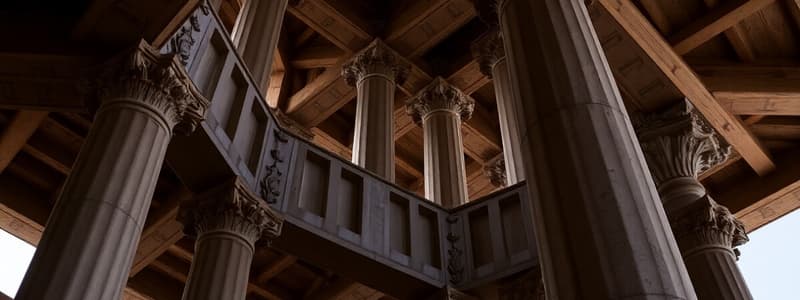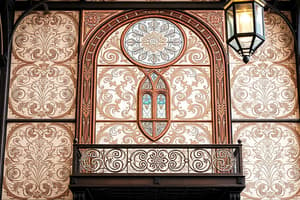Podcast
Questions and Answers
What primarily affects columns constructed to support central compressive loads?
What primarily affects columns constructed to support central compressive loads?
- Loads affected at their ends (correct)
- Lateral shear forces
- Torsional stresses
- Loads concentrated at the center
Slender, long columns are more prone to collapse due to crushing rather than buckling.
Slender, long columns are more prone to collapse due to crushing rather than buckling.
False (B)
What is the primary force that beams are subjected to?
What is the primary force that beams are subjected to?
- Bending and Deflection (correct)
- Shear only
- Compression only
- Torsion only
What term describes the vertical displacement of a beam from its original position under load?
What term describes the vertical displacement of a beam from its original position under load?
At what part is the effectiveness of a beam said to be raised by reinforcing it?
At what part is the effectiveness of a beam said to be raised by reinforcing it?
An overhanging beam is fixed only on one side, with the other end free.
An overhanging beam is fixed only on one side, with the other end free.
In plate structures, loads are distributed in multiple directions, following the _______ path to the ends.
In plate structures, loads are distributed in multiple directions, following the _______ path to the ends.
Which of the following is a characteristic of plate structures?
Which of the following is a characteristic of plate structures?
What distinguishes a folded plate structure from a regular plate structure?
What distinguishes a folded plate structure from a regular plate structure?
In folded plate structures, each surface acts as a column increasing the cross section's stiffness.
In folded plate structures, each surface acts as a column increasing the cross section's stiffness.
What geometric shape do trusses depend on for stiffness?
What geometric shape do trusses depend on for stiffness?
What type of forces should be applied to a structure composed of trusses?
What type of forces should be applied to a structure composed of trusses?
The distance between vertical supports, dictated by the spanning capability of horizontal structural elements, is known as the _______.
The distance between vertical supports, dictated by the spanning capability of horizontal structural elements, is known as the _______.
What is the primary function of arches in structural design?
What is the primary function of arches in structural design?
Vaults are characterized by a triangular cross section forming a ceiling.
Vaults are characterized by a triangular cross section forming a ceiling.
What is formed by the perpendicular intersection of two vaults?
What is formed by the perpendicular intersection of two vaults?
What is dome a part of?
What is dome a part of?
Geodesic domes are constructed exclusively from steel components.
Geodesic domes are constructed exclusively from steel components.
What is a key characteristic of the dome surface in a geodesic dome?
What is a key characteristic of the dome surface in a geodesic dome?
Cable structures utilize inclined or vertical _______ from which cables extend to lift up horizontal elements
Cable structures utilize inclined or vertical _______ from which cables extend to lift up horizontal elements
What is the spatial arrangement of horizontal elements within a cable structure?
What is the spatial arrangement of horizontal elements within a cable structure?
Fabric membrane structures primarily transfer loads via compressive stress.
Fabric membrane structures primarily transfer loads via compressive stress.
What two methods can be used to raise membrane structures?
What two methods can be used to raise membrane structures?
Match the following structural units with their descriptions:
Match the following structural units with their descriptions:
Which of the following is NOT a type of beam?
Which of the following is NOT a type of beam?
Flashcards
Columns
Columns
Slender, rigid structures mainly supporting compressive loads at their ends.
Column Failure
Column Failure
Failure occurs when a central load exceeds the column's compressive power.
Beams
Beams
Horizontal components that transmit loads over space to columns.
Beam Deflection
Beam Deflection
Signup and view all the flashcards
Bending Moment
Bending Moment
Signup and view all the flashcards
Simple Beam
Simple Beam
Signup and view all the flashcards
Cantilever Beam
Cantilever Beam
Signup and view all the flashcards
Overhanging Beam
Overhanging Beam
Signup and view all the flashcards
Double Overhanging Beam
Double Overhanging Beam
Signup and view all the flashcards
Plate Structure
Plate Structure
Signup and view all the flashcards
Common Plate Structure
Common Plate Structure
Signup and view all the flashcards
Folded Plate Structure
Folded Plate Structure
Signup and view all the flashcards
Truss
Truss
Signup and view all the flashcards
Structural Span
Structural Span
Signup and view all the flashcards
Arch
Arch
Signup and view all the flashcards
Vault
Vault
Signup and view all the flashcards
Cross Vault
Cross Vault
Signup and view all the flashcards
Dome
Dome
Signup and view all the flashcards
Geodesic Dome
Geodesic Dome
Signup and view all the flashcards
Cable Structure
Cable Structure
Signup and view all the flashcards
Fabric Membrane Structure
Fabric Membrane Structure
Signup and view all the flashcards
Study Notes
- Discusses structural units in architecture and interior design.
- Lists columns, beams, plate structures, trusses, arches and vaults, domes, cable structures, and fabric membrane structures.
Columns
- Slender, rigid structures mainly support central compressive loads at their ends.
- Failure occurs when a central load exceeds the column's compressive power.
- Slender, long columns are prone to collapse by buckling.
- Buckling stress causes the column to sidetrack horizontally, inducing more buckling until failure.
- Thick, short columns are prone to collapse by crushing.
Beams
- Horizontal components transmit loads over space to columns.
- Subjected to bending and deflection forces.
- Deflection: the vertical space a beam moves from its original position under loads.
- Bending moment: a force trying to cause a structure to bend.
- Reinforcing the edges and using a deeper section can raise effectiveness where maximum bending stress occurs.
Beam Types
- Simple beam: supported at its ends.
- Cantilever beam: fixed on one side and free on the other.
- Overhanging beam: a simple beam projecting from one end.
- Double overhanging beam: a simple beam projecting from both ends, not exceeding 1/3 of the span.
Plate Structures
- Rigid, planar surface distributing loads in multiple directions, following the shortest path to the ends.
- Reinforced concrete slab is a common example.
- Reinforced concrete slabs lie in one plane.
Folded Plate Structures
- Consist of multiple deep, thin surfaces connected at their edges with sharp angles.
- Every surface acts as a beam, increasing the cross-section stiffness.
- Able to span a long distance due to the rigidity of the cross-section.
Truss
- A rigid structure is made of linear elements that rely on the stiffness of the triangle.
- Exposed only to axial compression or tension forces.
- Loads must be added only at the panel points.
Structural Span
- The distance between vertical supports, is determined by the spanning capability of horizontal structural elements.
Arches
- Curved structures span openings and convert the supported load's forces to diagonal components.
Vaults
- Have a semicircular cross-section, forming a ceiling.
- Reinforced concrete, brick, and stone: can be used in construction.
- The perpendicular intersection of two vaults forms a cross vault.
Dome
- One part of a sphere can be constructed from reinforced concrete, brick, or short linear elements such as the geodesic dome.
Geodesic Dome
- Has steel, wood, or similar materials.
- Components pursue three main groups of circles.
- The surface is subdivided into equilateral spherical triangles intersecting at 60 degrees.
Cable Structures
- Utilize inclined or vertical supports from which cables extend to lift up horizontal elements
- Horizontal elements are coordinated in a radial or parallel order.
Fabric Membrane Structures
- Membranes are flexible thin fabrics that transfer loads mainly via tensile stress.
- These could be raised by air pressure or by being stretched/extended between supports.
Studying That Suits You
Use AI to generate personalized quizzes and flashcards to suit your learning preferences.


